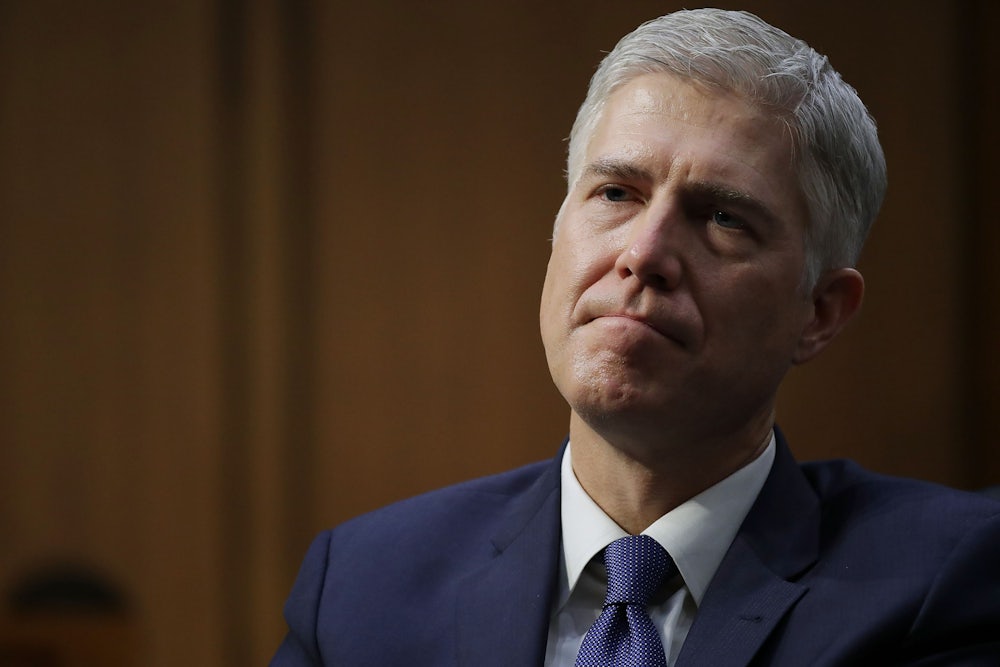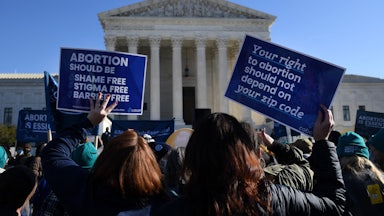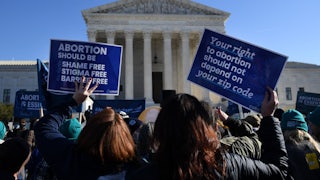The Supreme Court left most of Texas’s anti-abortion bounty law intact on Friday, ruling that abortion providers could not sue most state officials in federal court to challenge Texas Senate Bill 8. At the same time, the court ruled that the clinics had standing to sue a group of state medical regulators over the law’s enforcement, handing them a partial victory in the high-profile battle over abortion rights in Texas.
“Each of these individuals is an executive licensing official who may or must take enforcement actions against the petitioners if they violate the terms of Texas’s Health and Safety Code, including S.B. 8,” Justice Neil Gorsuch wrote for the majority. “Accordingly, we hold that sovereign immunity does not bar the petitioners’ suit against these named defendants at the motion to dismiss stage.” The decision will allow the clinics to continue their lawsuit in the lower federal courts, and they will likely seek an injunction to block S.B. 8’s enforcement while that litigation unfolds. (The Supreme Court declined to issue an injunction itself.)
Friday’s ruling in Whole Woman’s Health v. Jackson ensures that S.B. 8 will not escape the scrutiny of federal judges, at least for now. But it also amounts to a vindication of sorts for state laws that seek to nullify federal constitutional rights through private enforcement. In a simultaneous move, the justices also dismissed a lawsuit brought by the Justice Department against the state of Texas, effectively nixing the Biden administration’s effort to block the law through the Supremacy Clause. Four of the justices warned that the court should have acted more forcefully to block such laws.
“The clear purpose and actual effect of S.B. 8 has been to nullify this Court’s rulings,” Chief Justice John Roberts wrote in a partial dissent, joined by Justices Stephen Breyer, Sonia Sotomayor, and Elena Kagan, in which he quoted from landmark Supreme Court rulings on the high court’s role in the federal system. “Indeed, ‘if the legislatures of the several states may, at will, annul the judgments of the courts of the United States, and destroy the rights acquired under those judgments, the Constitution itself becomes a solemn mockery.’ The nature of the federal right infringed does not matter; it is the role of the Supreme Court in our constitutional system that is at stake.”
Sotomayor went even further than Roberts to castigate the majority. She compared Texas’s efforts to circumvent the federal courts to those of John C. Calhoun, the nineteenth-century apostle of states’ rights and nullification in defense of slavery. “By foreclosing suit against state-court officials and the state attorney general, the Court effectively invites other States to refine S.B. 8’s model for nullifying federal rights,” Sotomayor warned, writing in a separate dissent joined by Breyer and Kagan. “The Court thus betrays not only the citizens of Texas, but also our constitutional system of government.”
S.B. 8, which was passed by the Texas legislature earlier this year, is a near-total ban on abortions performed within the state. Previous state-level attempts to ban abortion were enforced by state officials. Abortion clinics would respond by invoking a provision in federal law known as Section 1983, which allows people to sue state and local officials for violating federal constitutional rights in federal courts. Since Roe v. Wade and Planned Parenthood v. Casey haven’t been overturned yet, those bans would invariably be blocked by federal judges.
Texas sought an end-run around this pattern of defeats by circumventing Section 1983 itself. S.B. 8 allows private parties to sue anyone who “aids or abets” most abortions performed after six weeks of gestation, which is often before many women know they are pregnant at all. The law explicitly forbids state officials from filing those lawsuits to evade federal review, while also encouraging private citizens—strangers, really, since they aren’t required to show any injury or relationship with the woman or her physician—to file them, by awarding at least $10,000 in damages if they prevail. Other procedural tricks in the law slant the cases in the plaintiffs’ favor.
After the law’s passage, a group of abortion providers sued a wide range of parties—including a state court judge, a state court clerk, Texas Attorney General Ken Paxton, a group of state medical regulators, and a private citizen whom they claimed would file an S.B. 8 lawsuit against them—in an attempt to find standing to challenge the law. The state of Texas, which defended the officials in court, argued that a variety of Supreme Court precedents and procedural hurdles blocked the clinics’ effort at each turn. The Fifth Circuit Court of Appeals lifted a lower court’s injunction against S.B. 8 in August, and the Supreme Court declined to reinstate it in September. The justices then agreed to consider the procedural aspects of the case in full on an expedited schedule.
Friday’s ruling was somewhat fractured. All nine justices agreed that the clinics could not sue state court judges to challenge S.B. 8; they also declined to allow them to continue to sue the private citizen, who had filed a sworn statement that he would not bring an S.B. 8 lawsuit. Five of them—Gorsuch and Justices Clarence Thomas, Samuel Alito, Brett Kavanaugh, and Amy Coney Barrett—also refused to allow them to sue state court clerks or the Texas attorney general. But eight of them agreed that the state medical regulators were fair game, with Thomas alone arguing that the clinics had no standing at all to challenge S.B. 8 in this manner.
The 5–4 split over the state court clerks and the Texas attorney general proved to be the deepest divide among the justices. In the 1905 case Ex parte Young, the court said that federal courts generally couldn’t issue injunctions against state court judges or clerks because they were not adverse parties in a case. Roberts argued that S.B. 8’s structure fell outside those limits. “Under these circumstances, the court clerks who issue citations and docket S.B. 8 cases are unavoidably enlisted in the scheme to enforce S.B. 8’s unconstitutional provisions, and thus are sufficiently connected to such enforcement to be proper defendants,” he wrote.
But Gorsuch and the majority disagreed that the situation differed enough from what Young proscribed. “Private parties who seek to bring S.B. 8 suits in state court may be litigants adverse to the petitioners,” he wrote. “But the state-court clerks who docket those disputes and the state-court judges who decide them generally are not. Clerks serve to file cases as they arrive, not to participate as adversaries in those disputes.” Gorsuch wrote that it was logically untenable for the dissenters to argue that the judges could not be sued as adverse parties but their clerks could be.
The divide is partly explained by how each bloc of justices views the Texas law in question. In their respective dissents, Roberts and Sotomayor cast S.B. 8 as something extraordinary, amounting both to a direct challenge to the Supreme Court’s authority and a threat to the judicial protection of federal constitutional rights in general. Roberts noted that the law “has had the effect of denying the exercise of what we have held is a right protected under the Federal Constitution” and that Texas had “employed an array of stratagems designed to shield its unconstitutional law from judicial review.” This is, in other words, no mere question of procedural niceties, but a direct assault on the nation’s constitutional structure.
Sotomayor also emphasized how the law’s ultimate goals cannot be separated from its structural features. “No party has identified any prior circumstance in which a State has delegated an enforcement function to the populace, disclaimed official enforcement authority, and skewed state-court procedures to chill the exercise of constitutional rights,” she wrote. “Because S.B. 8’s architects designed this scheme to evade Young as historically applied, it is especially perverse for the Court to shield it from scrutiny based on its novelty.”
Throughout his majority opinion, however, Gorsuch emphasized that challenges to S.B. 8 must be strictly held to existing precedent. In practical terms, that amounts to a major victory for the law’s drafters, who consciously designed it to exploit the gaps in those same precedents. But the dissenting justices saw no reason to reward S.B. 8 for being too clever by half. “Any novelty in this remedy is a direct result of the novelty of Texas’s scheme,” Roberts noted, echoing Sotomayor.
S.B. 8 targeted abortion rights in particular, but the law’s critics warily noted that it could be applied elsewhere. “What are federal courts to do if, for example, a State effectively prohibits worship by a disfavored religious minority through crushing ‘private’ litigation burdens amplified by skewed court procedures, but does a better job than Texas of disclaiming all enforcement by state officials?” Sotomayor asked. “Perhaps nothing at all, says this Court. Although some path to relief not recognized today may yet exist, the Court has now foreclosed the most straightforward route under its precedents. I fear the Court, and the country, will come to regret that choice.”
That argument, however, did not appear to faze the majority. They insisted on reading all parts of the law, even the bounty mechanism, as a run-of-the-mill state law. “Somewhat analogous complaints could be [leveled] against private attorneys general acts, statutes allowing for private rights of action, tort law, federal antitrust law, and even the Civil Rights Act of 1964,” Gorsuch replied, responding to Sotomayor’s critique of S.B. 8’s structure. “In some sense all of these laws ‘delegate’ the enforcement of public policy to private parties and reward those who bring suits with ‘bounties’ like exemplary or statutory damages and attorney’s fees.”
There are obvious differences between those laws and S.B. 8. Perhaps most obviously, they require the plaintiffs to show some kind of injury before bringing a lawsuit, which S.B. 8 does not, and they were not written with the express purpose of nullifying Supreme Court rulings. And there is something unsettling about the implicit comparison of S.B. 8 with the Civil Rights Act of 1964, which was passed not to deny anyone’s rights but to protect Americans from racial and sexual discrimination. That Gorsuch and his colleagues in the majority think otherwise is an ominous sign for future bounty-like laws that target other constitutional rights. And after Friday’s ruling, it may be a matter of when, not if, more of those laws appear.










